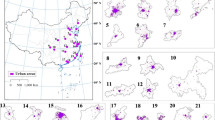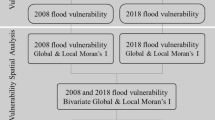Abstract
Built environment, which includes some major investments in Oman, has been designed based on historical data and do not incorporate the climate change effects. This study estimates potential variations of the hourly annual maximum rainfall (AMR) in the future in Salalah, Oman. Of the five climate models, two were selected based on their ability to simulate local rainfall characteristics. A two-stage downscaling–disaggregation approach was applied. In the first stage, daily rainfall projections in 2040–2059 and 2080–2099 periods from MRI-CGCM3 and CNRM-CM5 models based on two Representative Concentration Pathways (RCP8.5 and RCP4.5) were downscaled to the local daily scale using a stochastic downscaling software (LARS-WG5.5). In the second stage, the stochastically downscaled daily rainfall time series were disaggregated using K-nearest neighbour technique into hourly series. The AMRs, extracted from 20 years of projections for four scenarios and two future periods were then fitted with the generalized extreme value distribution to obtain the rainfall intensity–frequency relationship. These results were compared with a similar relationship developed for the AMRs in baseline period. The results show that the reduction in number of wet days and increases in total rainfall will collectively intensify the future rainfall regime. A marked difference between future and historical intensity–frequency relationships was found with greater changes estimated for higher return periods. Furthermore, intensification of rainfall regime was projected to be stronger towards the end of the twenty-first century.









Similar content being viewed by others
References
Alam M, Elshorbagy A (2015) Quantification of the climate change-induced variation in intensity–duration–frequency curves in the Canadian Prairies. J Hydrol 527:990–1005
Alexander LV, Zhang X, Peterson TC, Caesar J, Gleason B, Tank AMGK (2006) Global observed changes in daily climate extremes of temperature and precipitation. J Geophys Res. https://doi.org/10.1029/2005JD006290
Alila Y (2000) Regional rainfall depth–duration–frequency equations for Canada. Water Resour Res 36:1767–1778
Al-Rawas AG, Valeo C (2010) Relationship between wadi drainage characteristics and peak-flood flows in arid northern Oman. Hydrol Sci J 55:377–393
Demaria EMC, Maurer EP, Thrasher B, Vicuna S, Meza FJ (2013) Climate change impacts on an alpine watershed in Chile: do new model projections change the story. J Hydrol 502:128–138
Gunawardhana LN, Al-Rawas GA, Kwarteng AY, Al-Wardy M, Charabi Y (2018) Potential changes in the number of wet days and its effect on future intense and annual precipitation in northern Oman. Hydrol Res 49:237–250
Hassanzadeh E, Nazemi A, Elshorbagy A (2014) Quantile-based downscaling of rainfall using genetic programming: application to IDF curves in the City of Saskatoon. J Hydrol Eng 19:943–955
Herath SM, Sarukkalige PR, Nguyen VTV (2016) A spatial temporal downscaling approach to development of IDF relations for Perth airport region in the context of climate change. Hydrol Sci J 61:2061–2070
Herath SM, Sarukkalige PR, Nguyen VTV (2018) Evaluation of empirical relationships between extreme rainfall and daily maximum temperature in Australia. J Hydrol 556:1171–1181
Jenkinson AF (1955) The frequency distribution of the annual maximum (or minimum) values of meteorological elements. Q J R Meteorol Soc 81:158–171
Kazama S, Sato A, Kawagoe S (2009) Evaluating the cost of flood damage based on changes in extreme rainfall in Japan. Sustain Sci 4:61–69
Kharin VV, Zwiers FW, Zhang X, Wehner M (2013) Changes in temperature and precipitation extremes in the CMIP5 ensembles. Clim Change 119:345–357
Kwarteng AY, Dorvlo AS, Ganiga T, Kumar GTV (2009) Analysis of a 27-year rainfall data (1977–2003) in the Sultanate of Oman. Int J Climatol 29:605–617
Legates DR, Willmott CJ (1990) Mean seasonal and spatial variability in gauge-corrected, global precipitation. Int J Climatol 10:111–127
Lu Y, Qin XS, Mandapaka PV (2015) A combined weather generator and K-nearest-neighbour approach for assessing climate change impact on regional rainfall extremes. Int J Climatol 35:4493–4508. https://doi.org/10.1002/joc.4301
Membery D (2001) Monsoon tropical cyclones: part 1. Weather 56:431–438
Moss RH, Edmonds JA, Hibbard KA, Manning MR, Rose SK, Vuuren DP (2010) The next generation of scenarios for climate change research and assessment. Nature 463:747–756
Napolitano F, Koutsoyiannis D (2002) Multivariate rainfall disaggregation at a fine timescale. Water Resour Res 39:1173. https://doi.org/10.1029/2002WR001600
Nowak K, Prairie J, Rajagopalan B, Lall U (2010) A nonparametric stochastic approach for multisite disaggregation of annual to daily streamflow. Water Resour Res 46:W08529. https://doi.org/10.1029/2009WR008530
Ranjan P, Kazama S, Sawamoto M, Sana A (2009) Global scale evaluation of coastal fresh groundwater resources. Ocean Coast Manag 52:197–206
Semenov MA, Stratonovitch P (2010) The use of multi-model ensembles from global climate models for impact assessments of climate change. Clim Res 41:1–14
Sharif M, Burn DH (2007) Improved K-nearest neighbor weather generating model. J Hydrol Eng 12:42–51
Symon C (2013) Climate change: actions, trends and implications for business. In: The IPCC fifth assessment report, Working Group 1, pp 524–582. Cambridge University Press
Trenberth KE, Dai A, Rasmussen RM, Parsons DBZ (2003) The changing character of precipitation. Bull Am Meteorol Soc 84:1205–1217
Waters D, Watt WE, Marsalek J, Anderson BC (2003) Adaptation of a storm drainage system to accommodate increased rainfall resulting from climate change. J Environ Plan Manag 46:755–770
Yasuhara K, Murakami S, Mimura N, Komine H, Recio J (2007) Influence of global warming on coastal infrastructural instability. Sustain Sci 2:13–25
Yates D, Gangopadhyay S, Rajagopalan B, Strzepek K (2003) A technique for generating regional climate scenarios using a nearest-neighbor algorithm. Water Resour Res 39:1199. https://doi.org/10.1029/2002WR001769
Acknowledgements
This study was supported by the Internal Research Grant (IG/ENG/CAED/16/02) of the Sultan Qaboos University titled as “Trend between the renewal rate of the aquifer and the extreme climate events”.
Author information
Authors and Affiliations
Corresponding author
Rights and permissions
About this article
Cite this article
Gunawardhana, L.N., Al-Rawas, G.A. & Al-Hadhrami, G. Quantification of the changes in intensity and frequency of hourly extreme rainfall attributed climate change in Oman. Nat Hazards 92, 1649–1664 (2018). https://doi.org/10.1007/s11069-018-3271-6
Received:
Accepted:
Published:
Issue Date:
DOI: https://doi.org/10.1007/s11069-018-3271-6




